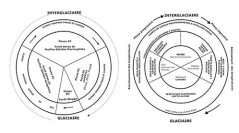

 Comptes Rendus Palevol
5 (1-2) - Pages 65-72
Comptes Rendus Palevol
5 (1-2) - Pages 65-72The already well-known pollen sequence from Velay illustrates the great complexity of the climate oscillations during the last 450 000 years (four climatic cycles). This sequence is compared with two records from northern Italy, Leffe (Lower Pleistocene till ca –1 Ma) and Piànico Sèllere (starting at ca –800 ka). It confirms that the glacial/interglacial cycles dramatically changed between 1 Ma and 800 ka. Lower Pleistocene cycles are shorter and warmer, with poorly marked glacial intervals; the climatic amplitude of Middle Pleistocene cycles is greater, from cold and dry glacial to interglacial optimums similar to the present. This change corresponds to the setting of the 100 000-year cycles associated with a major extinction phase for forest trees unable to survive during glacial intervals.
Pollen analysis, long records, Pleistocene, Western Europe